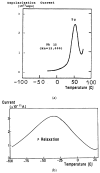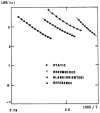Interactive Coupling Relaxation of Dipoles and Wagner Charges in the Amorphous State of Polymers Induced by Thermal and Electrical Stimulations: A Dual-Phase Open Dissipative System Perspective
- PMID: 39861311
- PMCID: PMC11768542
- DOI: 10.3390/polym17020239
Interactive Coupling Relaxation of Dipoles and Wagner Charges in the Amorphous State of Polymers Induced by Thermal and Electrical Stimulations: A Dual-Phase Open Dissipative System Perspective
Abstract
This paper addresses the author's current understanding of the physics of interactions in polymers under a voltage field excitation. The effect of a voltage field coupled with temperature to induce space charges and dipolar activity in dielectric materials can be measured by very sensitive electrometers. The resulting characterization methods, thermally stimulated depolarization (TSD) and thermal-windowing deconvolution (TWD), provide a powerful way to study local and cooperative relaxations in the amorphous state of matter that are, arguably, essential to understanding the glass transition, molecular motions in the rubbery and molten states and even the processes leading to crystallization. Specifically, this paper describes and tries to explain 'interactive coupling' between molecular motions in polymers by their dielectric relaxation characteristics when polymeric samples have been submitted to thermally induced polarization by a voltage field followed by depolarization at a constant heating rate. Interactive coupling results from the modulation of the local interactions by the collective aspect of those interactions, a recursive process pursuant to the dynamics of the interplay between the free volume and the conformation of dual-conformers, two fundamental basic units of the macromolecules introduced by this author in the "dual-phase" model of interactions. This model reconsiders the fundamentals of the TSD and TWD results in a different way: the origin of the dipoles formation, induced or permanent dipoles; the origin of the Wagner space charges and the Tg,ρ transition; the origin of the TLL manifestation; the origin of the Debye elementary relaxations' compensation or parallelism in a relaxation map; and finally, the dual-phase origin of their super-compensations. In other words, this paper is an attempt to link the fundamentals of TSD and TWD activation and deactivation of dipoles that produce a current signal with the statistical parameters of the "dual-phase" model of interactions underlying the Grain-Field Statistics.
Keywords: TSD; TWD; amorphous state; compensations; dual-phase model; grain-field statistics; interactive coupling; super-compensations; thermal depolarization kinetics; thermal-electrical stimulation; wagner charges.
Conflict of interest statement
The authors declare no conflict of interest.
Figures






































































Similar articles
-
Molecular relaxation behavior and isothermal crystallization above glass transition temperature of amorphous hesperetin.J Pharm Sci. 2014 Jan;103(1):167-78. doi: 10.1002/jps.23766. Epub 2013 Nov 1. J Pharm Sci. 2014. PMID: 24186540
-
Magneto-thermally activated spin-state transition in La0.95Ca0.05CoO3: magnetically-tunable dipolar glass and giant magneto-electricity.Phys Chem Chem Phys. 2016 Mar 7;18(9):6569-79. doi: 10.1039/c5cp06932g. Phys Chem Chem Phys. 2016. PMID: 26866898
-
Dielectric study of the molecular mobility and the isothermal crystallization kinetics of an amorphous pharmaceutical drug substance.J Pharm Sci. 2004 Jan;93(1):218-33. doi: 10.1002/jps.10520. J Pharm Sci. 2004. PMID: 14648651
-
Dipolar Glass Polymers Containing Polarizable Groups as Dielectric Materials for Energy Storage Applications. A Minireview.Polymers (Basel). 2019 Feb 13;11(2):317. doi: 10.3390/polym11020317. Polymers (Basel). 2019. PMID: 30960301 Free PMC article. Review.
-
The Challenges Facing the Current Paradigm Describing Viscoelastic Interactions in Polymer Melts.Polymers (Basel). 2023 Nov 2;15(21):4309. doi: 10.3390/polym15214309. Polymers (Basel). 2023. PMID: 37959989 Free PMC article. Review.
References
-
- Lacabanne C. Ph.D.Thesis. Université Paul Sabatier; Toulouse, France: 1974.
-
- Vanderschueren J. Ph.D.Thesis. University of Liege; Liège, Belgium: 1974.
-
- Van Turnout J. Thermally Stimulated Discharge of Polymer Electrets. Elsevier; Amsterdam, The Netherlands: 1975.
-
- Ibar J.P. Fundamentals of Thermal Stimulated Current (TSC) and Relaxation Map Analysis (RMA) SLP Press; Stratford, CT, USA: 1993.
-
- Ibar J.P. Dual-Phase Depolarization Analysis. Interactive Coupling in the Amorphous State of Polymers. de Gruyter; Berlin, Germany: Boston, MA, USA: 2022.
Publication types
LinkOut - more resources
Full Text Sources
Miscellaneous

